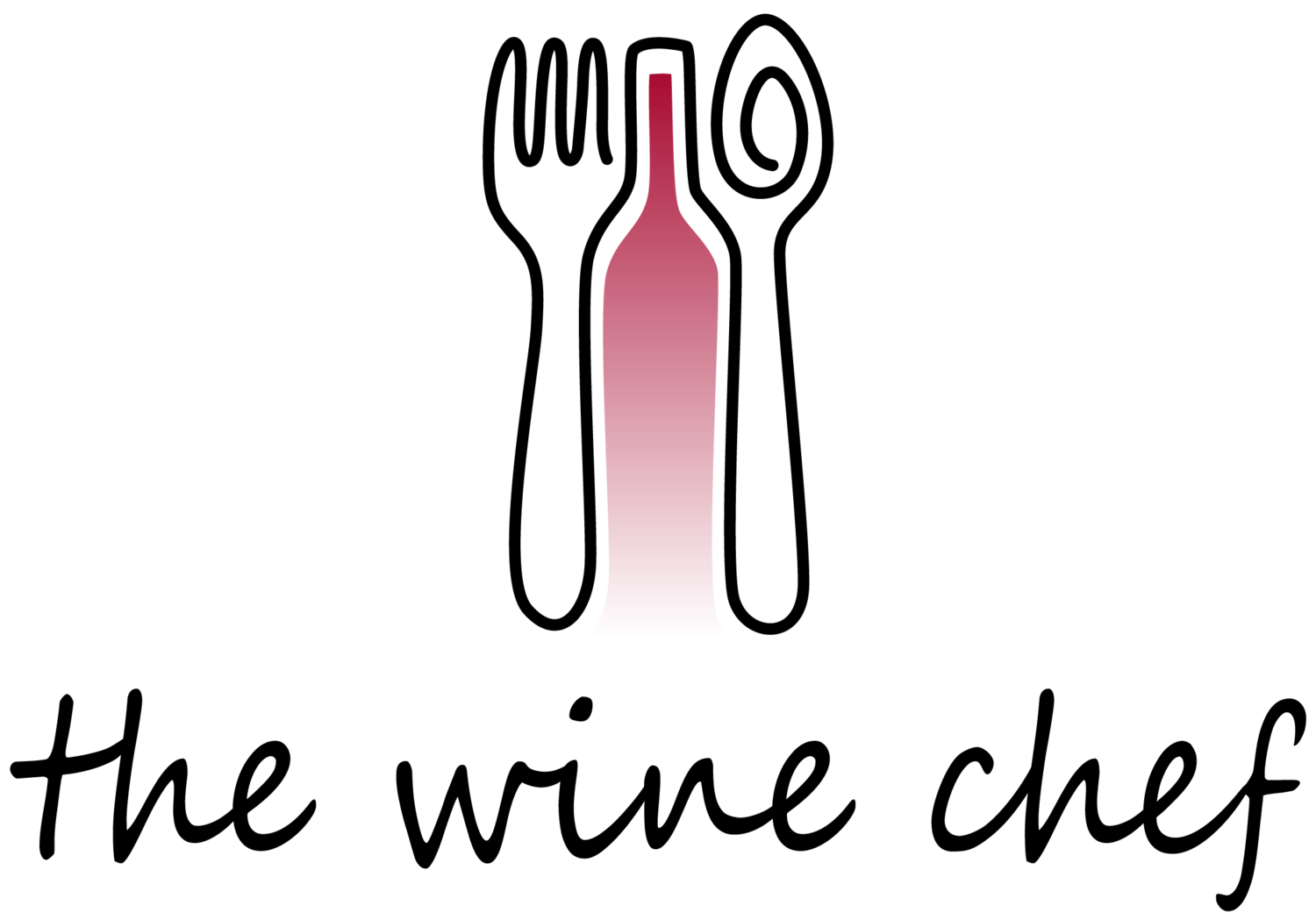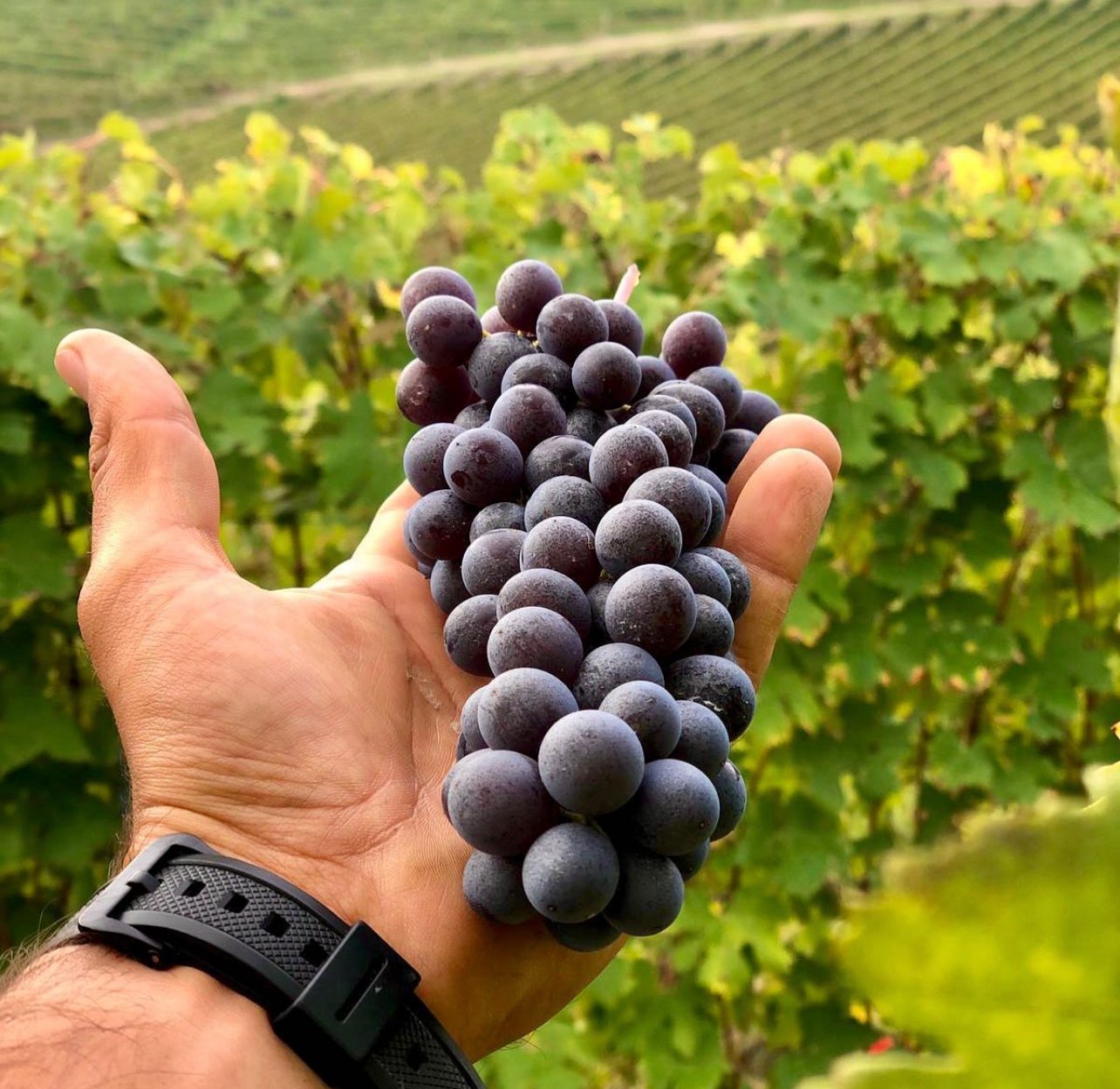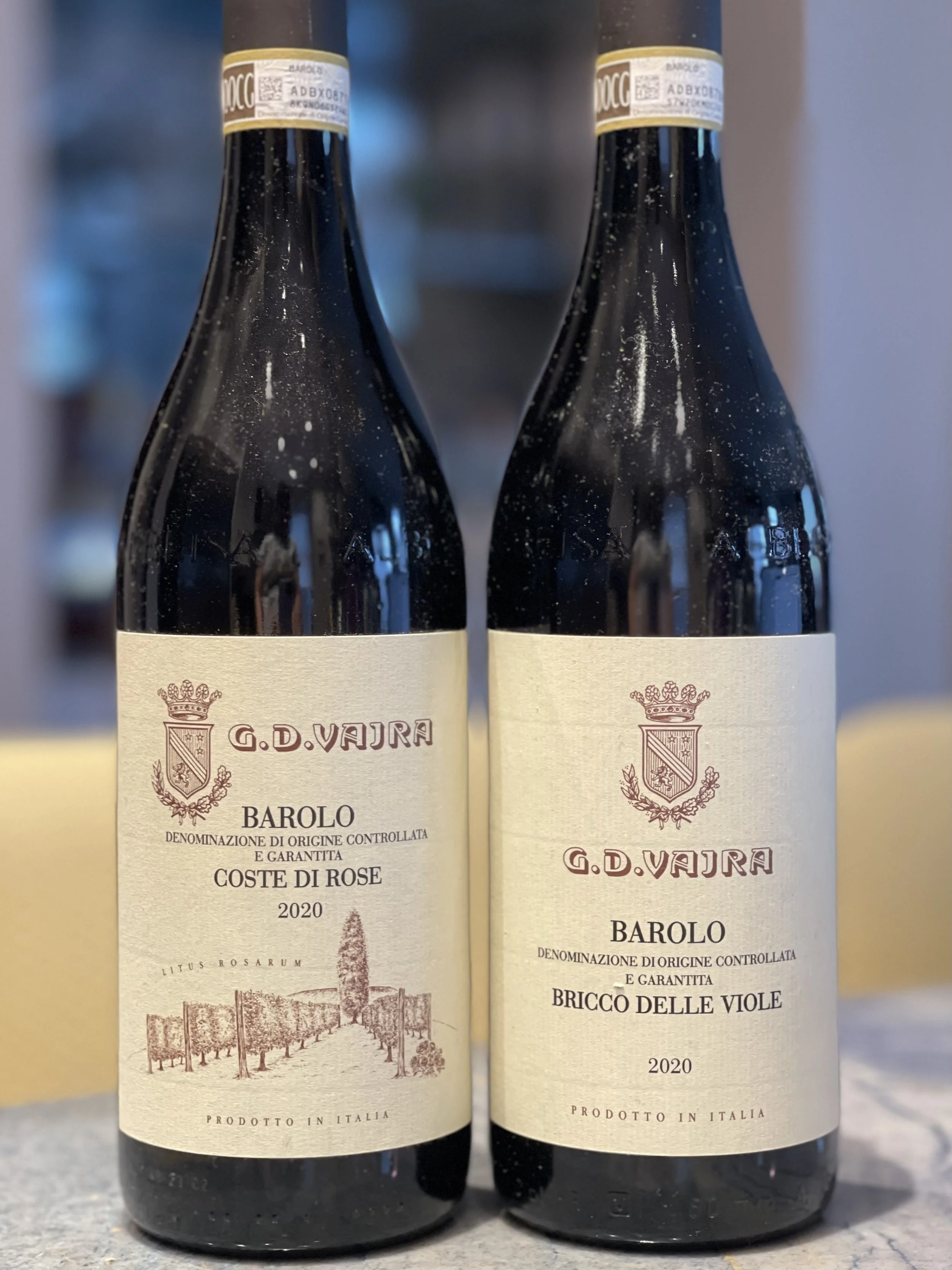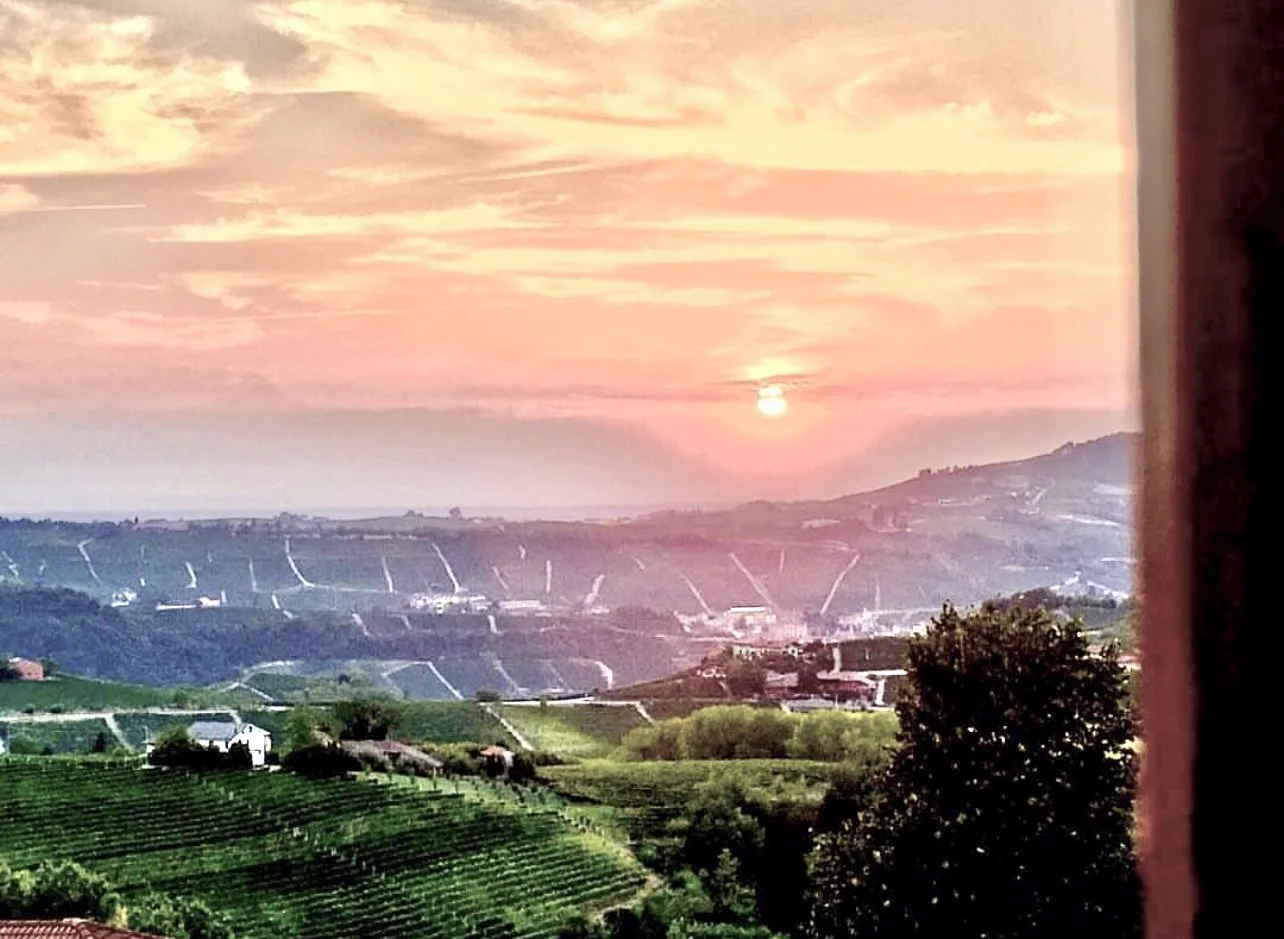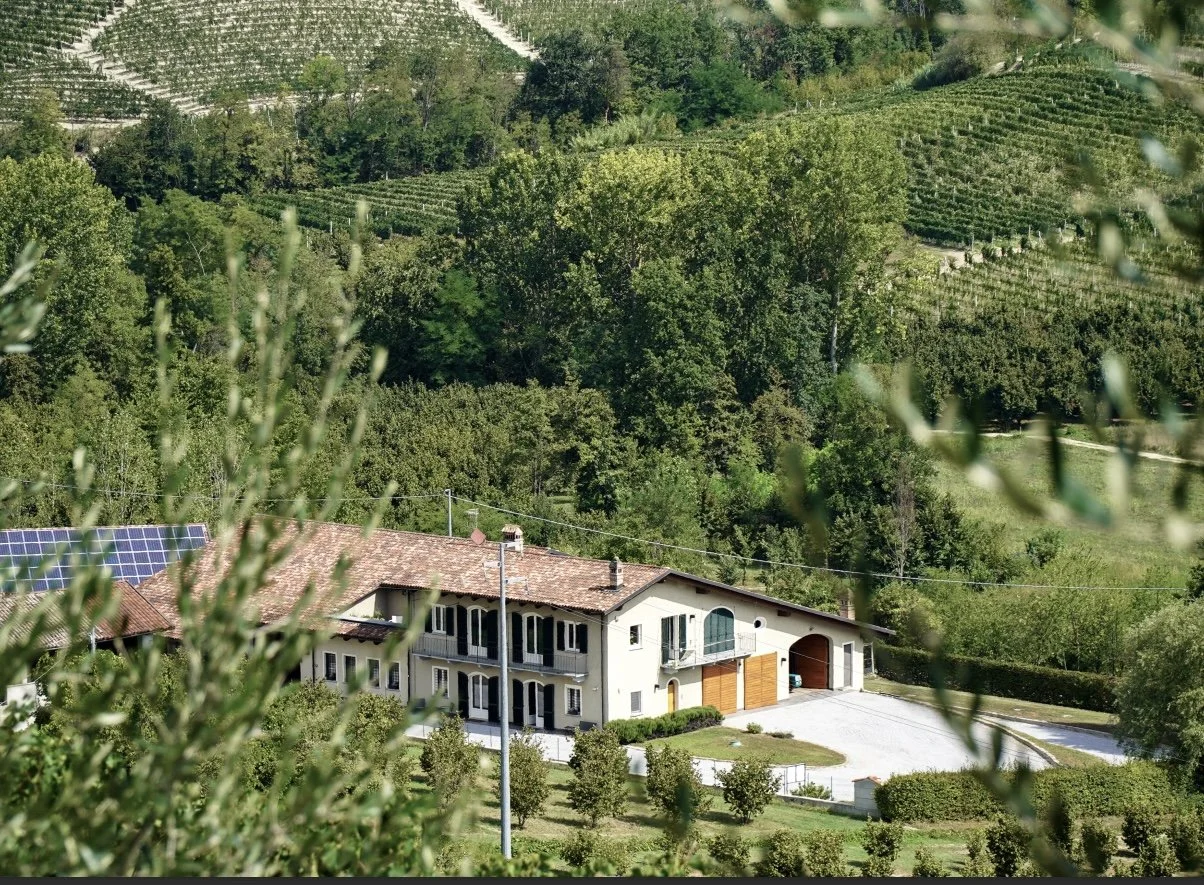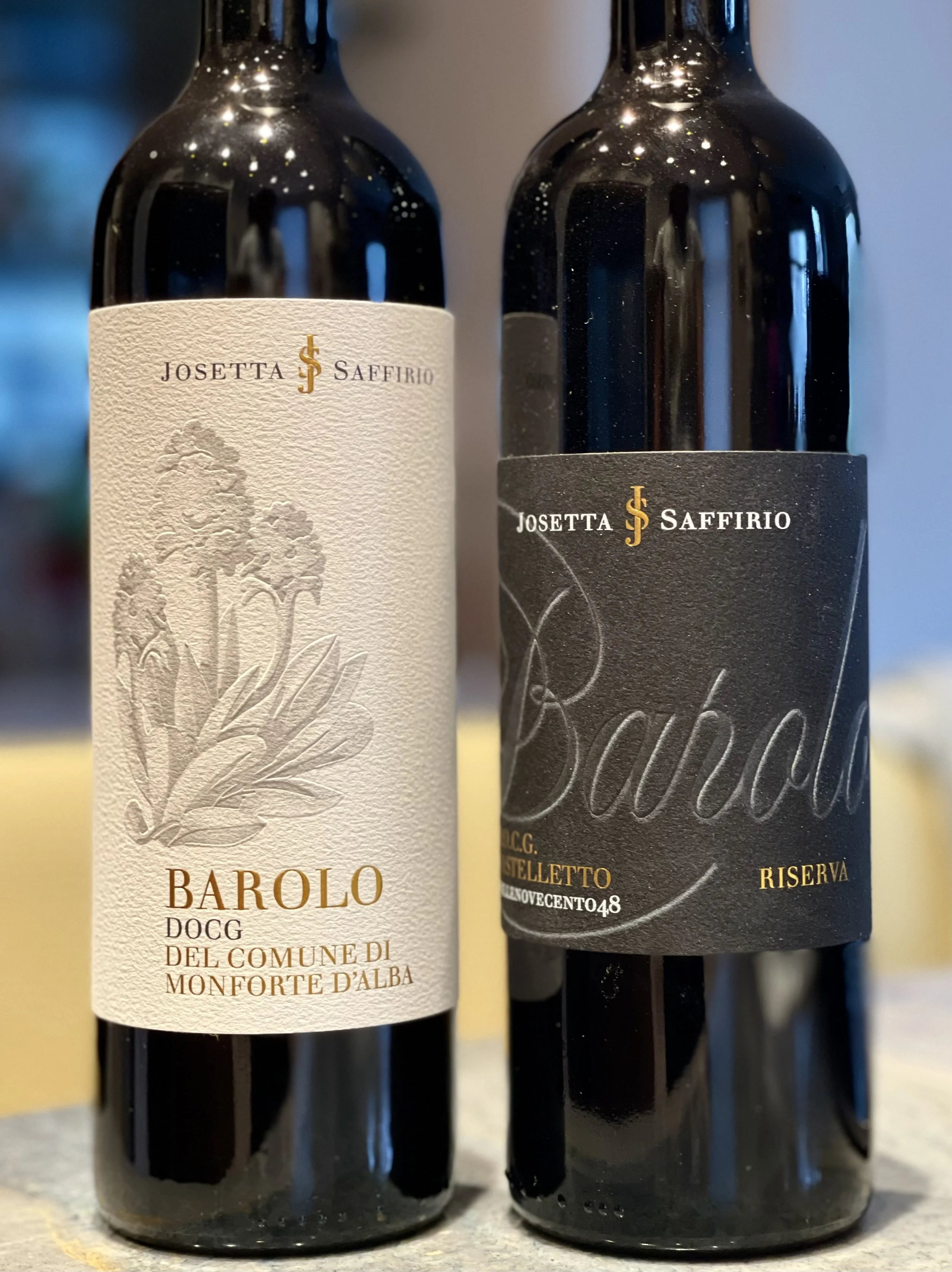A Taste of Barolo Through Three Family Wineries
/This week at The Wine Chef, we’re exploring Barolo, one of Italy’s most iconic wines. Barolo takes its name from a small hilltop town in the Langhe region of Piedmont and is made entirely from Nebbiolo grapes.
‘Nebbiolo’ comes from nebbia, meaning fog, a familiar sight in the vineyards during harvest. This thin-skinned, late-ripening grape can be a bit fussy, but when treated right, it rewards producers with wines that really show off their origins. In Barolo’s limestone and clay soils, it becomes something extraordinary: refined, complex, and built to age.
Nebbiolo grapes from Ravera, a single vineyard in Comune di Novello. Photo: @gdvajra_barolo
The Lay of the Land
The Barolo DOCG mandates that wines be made entirely from Nebbiolo grown in 11 designated communes. They are generally divided into two main valley zones, Central and Serralunga, resulting in different wine styles based on their soil composition. For example, Barolo and La Morra, from the limestone-based soils of the Central Valley, tend to produce fragrant, soft, and graceful styles.. Conversely, Serralunga and Monforte, from the sandstone and clay soils of the Serralunga Valley, yield darker, more structured, long-lived wines.
Other Piedmont appellations, such as Barbaresco, Roero, Gattinara, and Ghemme, also craft beautiful Nebbiolos. However, Barolo remains the benchmark, with the best examples marrying power and finesse: firm tannins and bright acidity balanced by delicate notes of rose, tar, and truffle.
Surprisingly, Barolo wasn’t always the dry red we know and love today. Until the mid-1800s, it was often made in a sweeter style. That changed when local winemaking practices evolved, introducing longer fermentations and more precise cellar techniques that transformed Barolo into a structured, age-worthy dry red wine. However, it wasn’t until the 1960s that Barolo finally gained recognition. Before then, Nebbiolo grapes sold for modest prices, and the wines were made in a simple, natural way, matured for years in large, old barrels, and sold locally, often in bulk.
Postcard Perfect
Visiting Barolo is like stepping straight into a painting. The charming landscape consists of tree-lined roads that wind through soft green hills dotted with vineyards, stone farmhouses, and ancient castles. The town of Barolo and its surrounding area offer a blend of wine-related tourism and outdoor activities, including hiking, cycling, and truffle hunting. You won’t find any large commercial shopping centers or big chain stores here. What you will find are small, local artisan shops selling specialty and handmade items, and, of course, wine.
The Price of Greatness
Barolo isn’t a bargain wine. Bottles typically start around $50 and can rise steeply from there, but it’s worth the occasional splurge, especially if the wine has some age. With ten years or more in the bottle, Barolo reveals its soul: a reflection of place, history, and generations who’ve learned to let Nebbiolo speak for itself.
Producers like Bartolo Mascarello, Giacomo Conterno, and Giuseppe Rinaldi have become synonymous with greatness, but their wines are often out of reach for most drinkers. Thankfully, Barolo is also full of smaller, family-run estates that care deeply for their vineyards, craft wines with the same spirit, and are a little easier on the wallet.
Over the past year, I’ve joined online tastings with three such producers whose wines give the heart and soul of Barolo in every bottle: G.D. Vajra, Giovanni Manzone, and Josetta Saffirio.
What unites these three wineries is devotion—to the land, to patience, and to a grape that refuses to be rushed. Barolo is not a wine of immediacy; it’s a wine of evolution over time. Each bottle tells a story of care and continuity that comes from listening closely to nature.
G.D. Vajra
Perched in the village of Vergne, the highest point in the Barolo commune, G.D. Vajra is known for wines that combine elegance, purity, and a true sense of place. The story of the winery begins in the 1970s with Aldo Vaira, whose path to farming was anything but typical.
Despite facing challenges such as hailstorms, financial worries, and family expectations, Aldo laid the foundation for G. D. Vajra. Today, the family, including Aldo’s children, Giuseppe, Francesca, and Isidoro, continues crafting beautiful Barolos from their high-altitude vineyards.
“My dad was one of the only kids of his generation to be born in the city of Torino and decide to become a farmer,” said Giuseppe Vaira during the Zoom tasting. “In those days, people just wanted a roof over their heads and a fixed salary. My father fell in love with farming and decided to go back to the land.”
A Hare on the lookout at G.D. Vajra’s Coste di Rose vineyard. Photo: @gdvajra_barolo
G.D. Vajra has also been a pioneer in organic farming, long before it became a trend. “We’ve been embracing organic farming since 1971,” says Giuseppe. “Back then, our meetings were almost like a secret society. There would be just a few of us talking after school with a professor about how to farm without chemicals.” That professor, Francesco Garofolo, was Aldo’s mentor and one of the first proponents of organic farming in Italy. At the time, a lot of the farmers’ financing came from agrichemical companies, which made the idea of going organic seem almost rebellious.
The wines are well-balanced, offering the lightness and transparency for which Nebbiolo is famous, along with lifted floral notes, bright red fruit, and silky tannins. The Vairas’ philosophy is simple: let the vineyard speak, intervene only when necessary, and let patience do the rest. Each bottle is a treasure of craftsmanship and a reflection of the land, the family, and a decades-long commitment to Barolo at its most expressive.
Try These G.D. Vajra Barolos
Coste di Rose – Bright, fragrant, and approachable, this Barolo is a perfect introduction to Vajra’s signature style. Aromas of red cherry and roses make it versatile enough to enjoy now, while still offering excellent aging potential. ($75)
Bricco delle Viole 2021 – A single-vineyard standout, with the elegance and finesse of high-altitude Vergne and its sweeping views over the hills. Floral and mineral notes, silky tannins, and a lifted, refined profile make it ideal for those looking to experience G.D. Vajra at its most expressive. ($98)
Giovanni Manzone
Nestled in the heart of the Langhe Hills at the intersection of Montforte d'Alba and Serralunga d'Alba, Giovanni Manzone celebrates an impressive 100th anniversary milestone in 2025. Founded in 1925 by Giovanni Manzone after World War I, this family estate has remained true to its roots through five generations. It is now led by Giovanni's grandson (also named Giovanni), along with his children Mauro and Mirella.
Views from Giovanni Manzone winery. Photo: @barolomanzone
The winery's story is one of perseverance and vision. During the Zoom tasting, Mauro recalled that his father grew up during challenging times. "When he was growing up, his father and grandfather would say to him, 'Why don't you leave, why don't you move away and find better luck, a better future?' He decided to remain because he loved agriculture. He loved nature and family."
Perched atop Castelletto hill at an altitude of 1,500 feet, the estate encompasses approximately 20 acres of meticulously tended vineyards. The Manzone family's philosophy centers on elegance and terroir expression rather than power. They age the wines in large casks without filtration to let the wines breathe and develop gently, while preserving their expressive fruit and subtle textures.
"We don't like over-extracted wines, the ‘bodybuilder Barolos,’" explained Mauro. "We prefer a more Burgundian style that shows the terroir, and Nebbiolo in its purity."
The Manzones care for the land, keeping forests and woodlands intact, and have never used pesticides or chemical fertilizers. “We respect nature,” says Mauro Manzone. “We work sustainably, and the vineyard tells us what to do each day—what the plant needs, what the weather requires.”
Try These Giovanni Manzone Barolos:
Barolo Castelleto 2020 – From their flagship vineyard steps from the winery, this Barolo shows ripe cherry, violet, and gentle earthy notes. Balanced tannins and bright acidity give lift and elegance, making it a versatile, inviting wine. ($55)
Barolo Bricat 2019 – Elegant single-vineyard Barolo with bright red cherry, dried rose, and a hint of forest floor. Silky tannins and subtle spice make it approachable now, yet it has the structure to age gracefully for years. ($80)
Josetta Saffirio
Founded in the early 20th century, Josetta Saffirio gained fame in the 1980s under the whimsical label art created by Josetta herself. Today, her daughter, Sara Vezza, leads the winery with a forward-thinking commitment to sustainability and modern winemaking. Sara farms her Monforte vineyards organically, using cover crops, bees, and solar power to support biodiversity. Her wines are elegant, fragrant, and transparent, yet still show the signature structure of Monforte Nebbiolo.
“Our Winery is a place of peace and excellence: every experience here is engaging and satisfying, from brunch to tastings paired with Langhe gastronomic specialties.” — Sara Vezza Photo: @josettasaffiriowinery
Sara’s family has deep roots in Monforte, and her grandfather’s determination—studying while working and serving as a soldier—inspires her still. “What impresses me most is that he decided to study on his own while working and even while serving as a soldier. He earned several degrees and attended university,” she says.
At 17, Sara intervened when her parents considered selling the estate. “I hadn’t studied winemaking. I was studying Latin and Greek,” she says, “but I loved our home and respected my family’s sacrifices.” Her first harvest produced 1,000 bottles; today, the estate makes 120,000 annually.
Beyond production, Sara transformed Josetta Saffirio into an organic, biodiversity-focused estate spanning 50 acres of vineyards and 40 acres of forest. “Becoming organic wasn’t a marketing decision,” she says. “It was a personal choice to live and work in a healthy environment. Plants communicate with each other. Biodiversity is essential.”
Josetta Saffirio produces approachable, yet age-worthy Barolos. “In the past, Barolo wines were heavily extracted with lots of new oak and alcohol,” she says. “Today, I prefer a more contemporary Barolo: elegant, transparent, expressive of Nebbiolo’s character.”
In addition to thoughtful, environmentally friendly vineyard practices, the estate embraces modern stewardship through the use of photovoltaic (solar) power and community programs. “I’m not leaving my children just vineyards, but a legacy of values,” Sara concludes.
Try These Josetta Saffirio Barolos
Barolo del Comune di Monforte d’Alba 2020 – Classic, refined Nebbiolo with bright red fruit, floral aromas, and gentle tannins. Approachable now, yet built for graceful aging. ($65)
Barolo Castelletto Millenovecento48 Riserva 2017 – From the historic Castelletto vineyard planted in 1948, this Riserva shows depth, structure, and elegance, with notes of cherry, rose, and forest floor. ($160)
